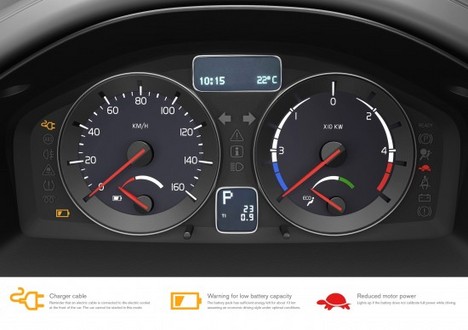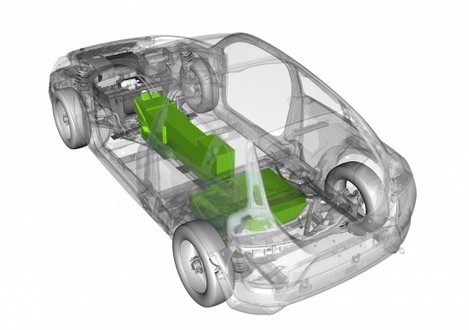
Electricity is highly suitable as a fuel for passenger cars. It is the superior energy efficiency of the electric motor compared with the combustion engine which suggests that electric cars will become increasingly common in the future as fuel prices rise and demands for low CO2 emissions become ever more stringent.
The Volvo C30 BEV is powered with a Litium-Ion battery that is charged via a regular power socket found in most homes.
Recharging an entirely depleted battery via the regular household power supply system (230V, 16A) will take about eight hours. If the car is charged with renewable electricity this means that emissions – all the way from electricity production to its use out on the road – will in principle be non-existent.
The electric motor is housed under the bonnet, just like the engine in a conventional car. One of the priorities within the BEV project is to find the optimal placing of the battery. Most likely is the prop shaft tunnel and the place where the fuel tank normally is located the best places. These locations are within the car’s optimised crumple zone in the most common collision scenarios. Since the car runs solely on electricity, it requires a larger battery with higher capacity (24 kWh) than in the case of the plug-in hybrid (12 kWh).
Battery capacity
The C30 BEV is limited to a top speed of about 130 kilometres an hour, which will be more than sufficient for most users of this type of car. Acceleration from 0 to 100 kilometres an hour will take less than 11 seconds. The car will have a range of up to 150 kilometres. This range is longer and far better than the distance 90 percent of all Europe’s motorists drive per day.
The same safety standards as always
Volvo Cars imposes the very same high safety standards on all its products irrespective of the type of fuel or power source used. Volvo’s safety dedication is always focused on the human being and is based on solid know-how of real-life traffic situations. What is more, comprehensive in-house tests are carried out both virtually and in Volvo’s highly advanced crash-test laboratory. If Volvo chooses to introduce an entirely new type of electric car on the market, it will be just as safe as any other car bearing the Volvo badge.
Volvo has theoretically identified all the electrification-related safety scenarios in the stages before, during and after a collision. After careful study of these scenarios, the company’s engineers will create solutions for handling each and every situation identified, guaranteeing that any future electric cars fully match Volvo’s renowned safety standards in every respect.
Market potential
Volvo Cars’ main electrification track over the coming decades is plug-in hybrids. This applies in particular to the company’s larger car models. The combination of electric motor and combustion engine is the solution that probably has the greatest potential from both the technical and commercial viewpoints. Plug-in hybrids offer long range, good environmental performance and at the same time limited dependence on expensive battery technology.
There are several factors that determine how successful dedicated electric cars will be in the future:
“The consumer must feel that this type of car is attractive both to drive and own. In order to ensure this, we feel that electric cars will have to be as comfortable and safe and offer similar levels of performance as cars with other power sources. The learning from the C30 BEV project will help us to fulfil all these criteria and showcase Volvo’s determination to drive developments in the field of electrification,” says Paul Gustavsson, Director of Electrification Strategy at Volvo Cars.







Car News, Car Review, Future, Auto, New Cars, Car Quote, Price











